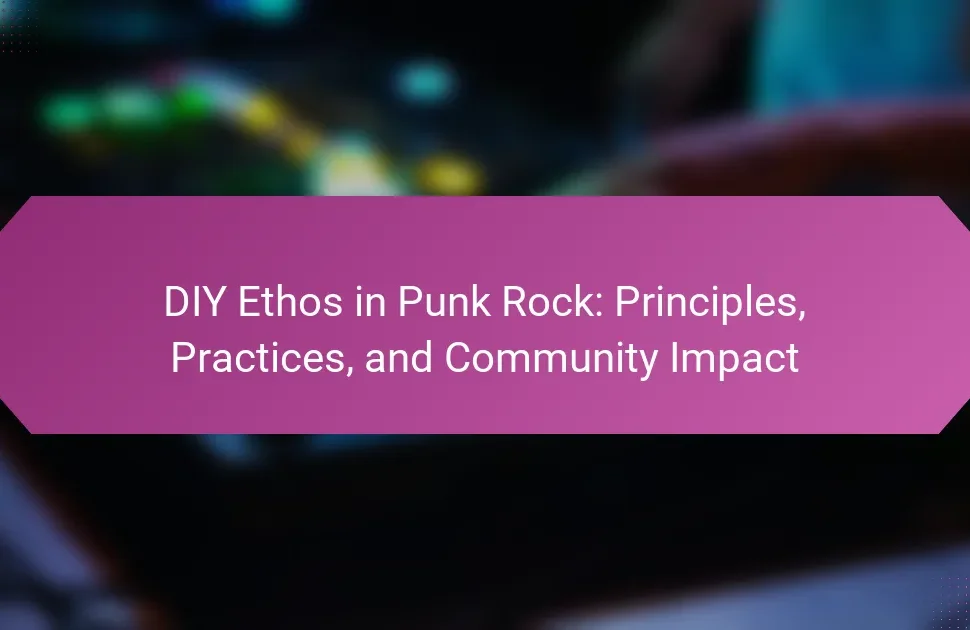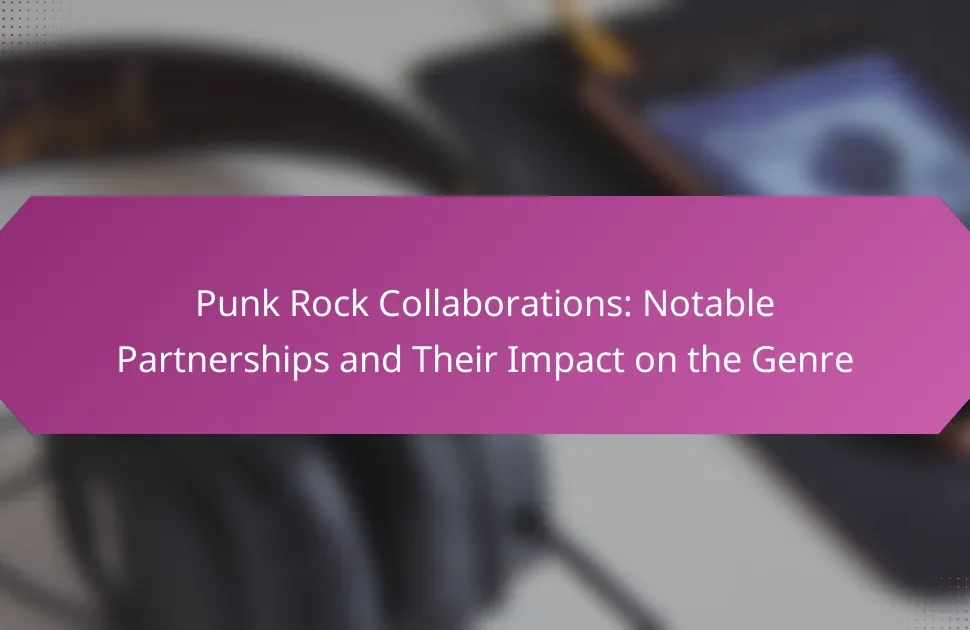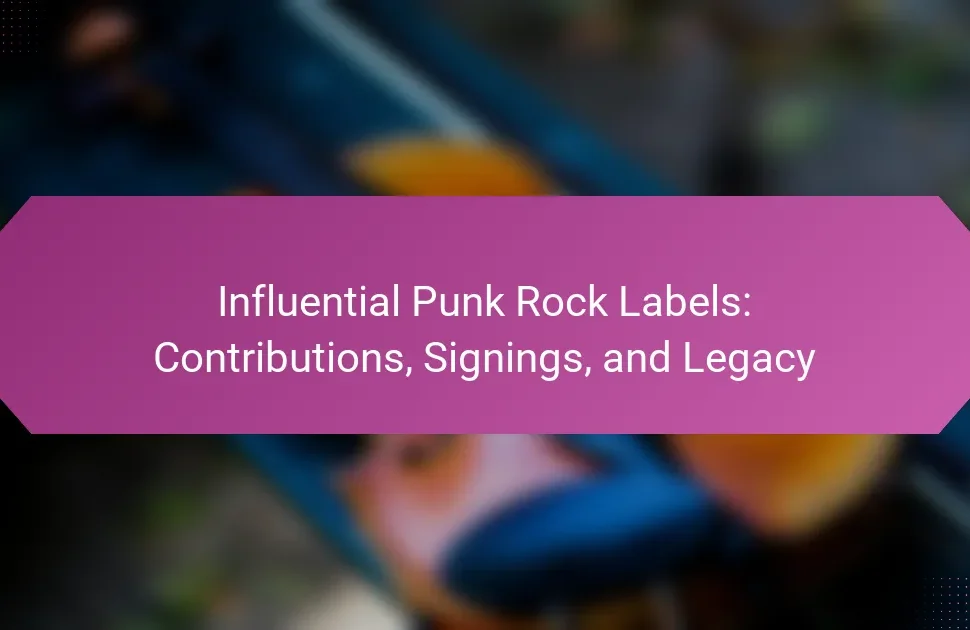Punk rock fashion revolutionizes style through its rebellious spirit and DIY ethos. This article explores its evolution from the 1970s, key influences and iconic figures, diverse subcultures, and current challenges in maintaining authenticity. Discover how punk aesthetics continue to shape contemporary fashion trends while reflecting cultural attitudes.
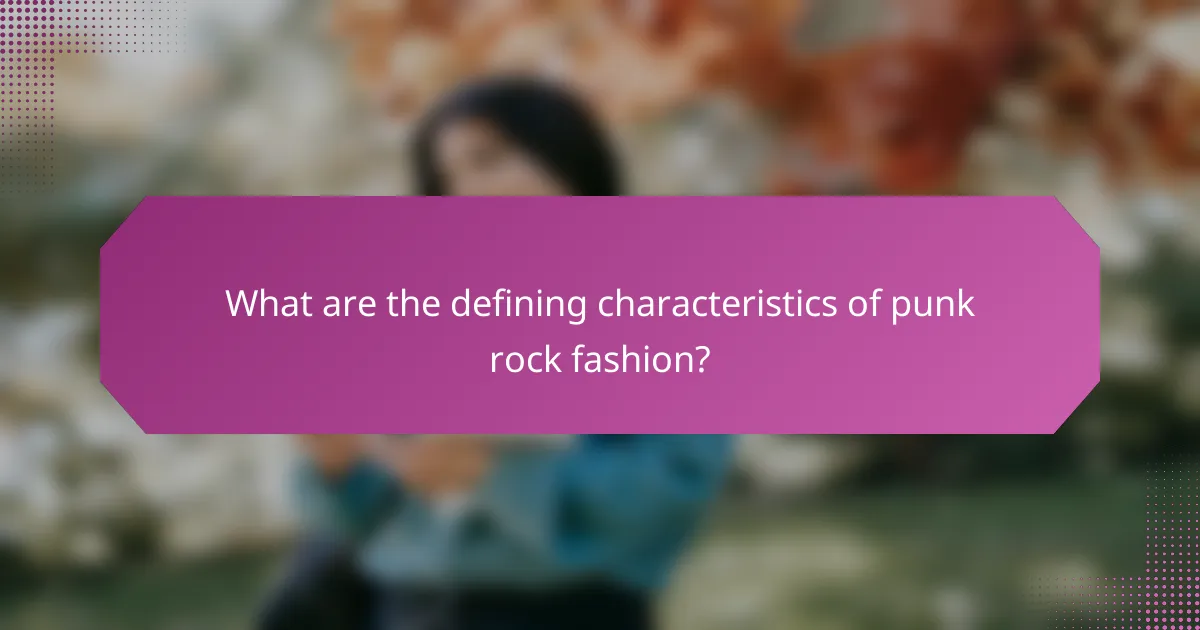
What are the defining characteristics of punk rock fashion?
Punk rock fashion is defined by its rebellious spirit, bold aesthetics, and DIY ethos. Key characteristics include distressed clothing, leather jackets, band t-shirts, and unconventional hairstyles. Accessories often feature spikes, studs, and chains, emphasizing a nonconformist attitude. The style draws from influences like 1970s garage rock and 1980s street culture, creating iconic looks that challenge mainstream fashion norms.
How does punk rock fashion reflect rebellion and individuality?
Punk rock fashion embodies rebellion and individuality through its bold aesthetics and anti-establishment ethos. The style emerged in the 1970s, characterized by torn clothing, leather jackets, and DIY accessories. This fashion reflects a rejection of societal norms and promotes self-expression. Iconic figures like Vivienne Westwood influenced its evolution, emphasizing unique, often provocative designs. Punk rock fashion remains a symbol of resistance, encouraging wearers to challenge conventions and assert their identities.
Why are DIY aesthetics important in punk rock fashion?
DIY aesthetics are crucial in punk rock fashion as they embody individuality and rebellion. This approach allows fans to express their unique identities through customized clothing and accessories. The DIY ethos fosters creativity, encouraging the use of unconventional materials and techniques. As a result, punk fashion becomes a canvas for personal expression, often reflecting social and political messages. The distinctiveness of each piece showcases the unique attributes of the wearers, reinforcing the community’s core values of authenticity and resistance against mainstream culture.
Which materials and colors are commonly used in punk rock fashion?
Punk rock fashion commonly uses materials like leather, denim, and cotton, with colors such as black, red, and plaid. Leather jackets and ripped jeans are iconic staples. The choice of these materials and colors reflects rebellion and individuality, key themes in punk culture.
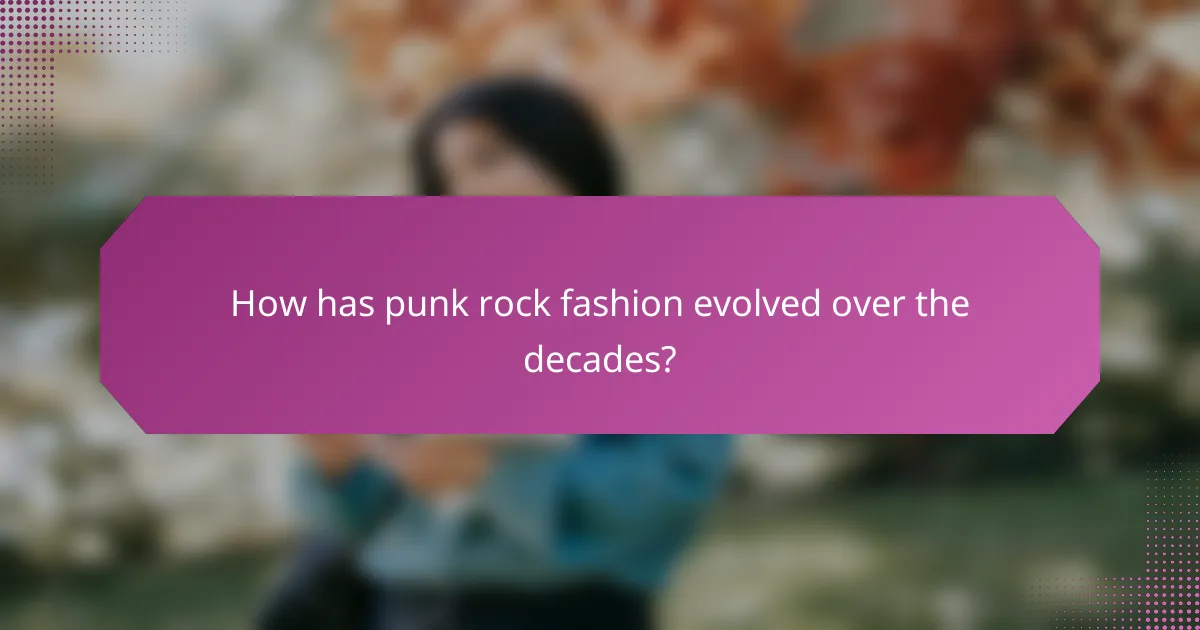
How has punk rock fashion evolved over the decades?
Punk rock fashion has evolved significantly since its inception in the 1970s. Initially characterized by DIY aesthetics, it embraced leather jackets, band tees, and ripped jeans. Over the decades, punk fashion has incorporated influences from various subcultures, including goth and grunge, leading to a diverse range of styles.
In the 1980s, punk fashion saw the emergence of bold colors, spikes, and accessories like chains and safety pins. The 1990s introduced a more mainstream appeal with brands adopting punk elements, while the 2000s focused on a fusion of punk with streetwear. Today, punk rock fashion continues to inspire contemporary designers, blending traditional punk elements with modern trends and sustainable practices.
This evolution reflects not only changes in fashion but also shifts in cultural attitudes, making punk rock fashion a dynamic and influential force in the industry.
What were the key influences on punk rock fashion in the 1970s?
Punk rock fashion in the 1970s was influenced by music, counterculture, and DIY ethos. Key influences included the glam rock scene, which introduced bold styles, and the working-class aesthetic that emphasized thrift and rebellion. Iconic bands like the Sex Pistols and The Ramones shaped the look with leather jackets, ripped jeans, and graphic tees. Additionally, punk fashion drew from earlier movements such as the beatniks and the mod subculture, creating a unique blend of styles that expressed defiance and individuality.
How did the 1980s bring new styles to punk rock fashion?
The 1980s introduced bold aesthetics and diverse influences to punk rock fashion. Key styles included vibrant colors, oversized silhouettes, and a mix of high fashion with DIY elements. This era saw punk evolve with the rise of designer collaborations, such as Jean Paul Gaultier, who incorporated punk themes into mainstream fashion. Unique attributes, like the use of leather, studs, and graphic tees, became defining features, showcasing individuality and rebellion. As a result, punk fashion in the 1980s became a significant cultural statement, influencing various music genres and fashion trends that followed.
What impact did the 1990s grunge movement have on punk rock fashion?
The 1990s grunge movement significantly influenced punk rock fashion by introducing a more relaxed and layered aesthetic. Grunge emphasized thrift store finds, flannel shirts, and distressed denim, which contrasted with the more aggressive styles of earlier punk. This blending resulted in a unique style that incorporated elements like combat boots and graphic tees. The casual approach of grunge made punk fashion more accessible, appealing to a broader audience. As a result, punk rock fashion evolved to embrace these new textures and patterns, creating a lasting impact on alternative style.
How is contemporary punk rock fashion defined in 2025?
Contemporary punk rock fashion in 2025 is defined by a blend of retro aesthetics and modern sustainability. Key elements include oversized silhouettes, bold graphics, and upcycled materials. Influences from 90s grunge and early 2000s streetwear are prominent. Unique attributes feature personalized accessories and a focus on ethical production. Rare elements include tech-integrated clothing that reflects punk’s rebellious spirit.
![]()
Which iconic figures have shaped punk rock fashion?
Vivienne Westwood, Malcolm McLaren, Debbie Harry, Sid Vicious, and Johnny Rotten significantly shaped punk rock fashion. Vivienne Westwood and Malcolm McLaren popularized the rebellious aesthetic through their London boutique, SEX. Debbie Harry infused glam and punk elements, influencing female punk style. Sid Vicious and Johnny Rotten embodied the raw, anti-establishment ethos, cementing iconic looks with leather jackets and spiked hair. Each figure contributed unique attributes, creating a diverse fashion landscape within the punk movement.
What styles did Johnny Rotten popularize?
Johnny Rotten popularized styles that defined punk rock fashion, including ripped clothing, leather jackets, and distinctive hairstyles. His bold aesthetic challenged mainstream norms and embraced anti-establishment themes. Key elements included safety pins, graphic t-shirts, and DIY accessories, reflecting a unique attribute of individuality and rebellion. Rotten’s influence remains a cornerstone of punk culture, inspiring future generations of musicians and fashion enthusiasts.
How did Vivienne Westwood influence punk fashion?
Vivienne Westwood significantly shaped punk fashion through her innovative designs and rebellious spirit. She introduced provocative clothing that challenged societal norms, blending high fashion with street style. Her boutique, Sex, became a hub for punk culture in the 1970s, showcasing items that featured safety pins, tartan patterns, and bold graphics. Westwood’s work emphasized individualism and anti-establishment sentiments, making her a key figure in the evolution of punk aesthetics. Her influence persists, inspiring contemporary designers who draw from her iconic styles and ethos.
Which modern influencers are redefining punk rock fashion today?
Contemporary influencers redefining punk rock fashion include Billie Eilish, who blends edgy aesthetics with mainstream appeal, and Yungblud, known for his vibrant, gender-fluid styles. These figures revive punk’s rebellious spirit while incorporating modern elements. Other notable influencers are Machine Gun Kelly, who merges punk with pop culture, and Olivia Rodrigo, who embodies youthful angst through her fashion choices. Each of these artists brings a unique attribute to punk rock fashion, showcasing its evolution in today’s music scene.
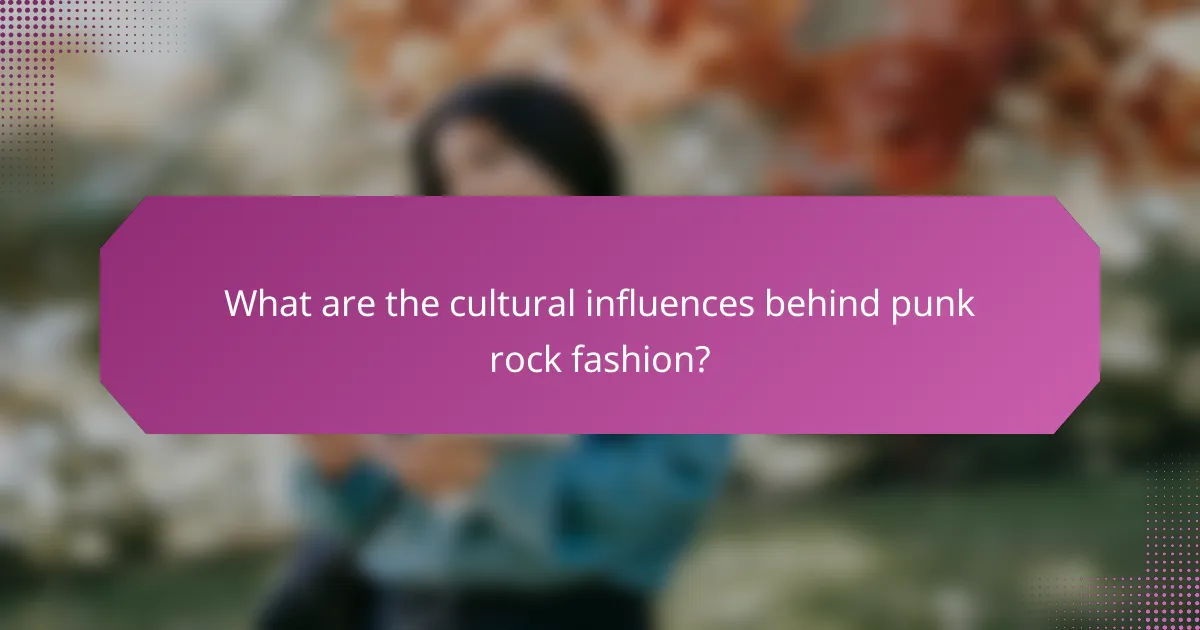
What are the cultural influences behind punk rock fashion?
Punk rock fashion is shaped by various cultural influences, including rebellion against mainstream norms, DIY aesthetics, and historical movements. The punk movement emerged in the 1970s, influenced by the anti-establishment sentiments of artists and social upheaval. Key attributes of punk rock fashion include the use of leather jackets, ripped jeans, and band T-shirts, reflecting a unique identity and attitude. Additionally, rare influences like the British punk scene and American street style contributed to its evolution, making it a distinctive cultural statement.
How does punk rock fashion intersect with music culture?
Punk rock fashion is deeply intertwined with music culture, reflecting rebellion and individuality. The aesthetic emerged in the 1970s, influenced by punk music’s anti-establishment ethos. Fashion choices, such as leather jackets and DIY elements, symbolize resistance against mainstream norms. Iconic bands like The Ramones and Sex Pistols popularized these styles, creating a visual representation of their music. The intersection of punk rock fashion and music culture continues to inspire contemporary artists, emphasizing authenticity and self-expression.
What role do political movements play in punk rock fashion?
Political movements significantly influence punk rock fashion by promoting anti-establishment sentiments and individual expression. The punk aesthetic often reflects resistance against societal norms, aligning with various political ideologies. For instance, the DIY ethos in punk fashion encourages self-made clothing, symbolizing autonomy and rebellion. Iconic styles, such as leather jackets and ripped jeans, serve as visual statements of defiance. Additionally, punk fashion often incorporates symbols and slogans that challenge authority, making it a powerful tool for political expression.

Which subcultures have emerged within punk rock fashion?
Punk rock fashion has given rise to several subcultures, each with distinct styles and influences. Key subcultures include goth punk, which incorporates dark aesthetics and Victorian elements; street punk, characterized by DIY fashion and urban influences; and pop punk, blending punk elements with mainstream trends and brighter colors. Other notable subcultures are ska punk, which features ska music influences and vibrant patterns, and crust punk, known for its anarchistic themes and rugged, often recycled clothing. Each subculture reflects unique values and attitudes within the broader punk rock movement.
What differentiates street punk from pop punk styles?
Street punk is characterized by its raw, aggressive style, while pop punk features more melodic and accessible elements. Street punk often embraces a DIY ethos, with fashion reflecting rebellion through distressed clothing and bold graphics. In contrast, pop punk leans towards a polished aesthetic, incorporating brighter colors and mainstream influences. Both styles have unique attributes; street punk focuses on anti-establishment messages, whereas pop punk often explores themes of youth and relationships.
How do the aesthetics of goth punk differ from traditional punk rock fashion?
Goth punk fashion emphasizes dark, romantic aesthetics, contrasting with traditional punk rock’s raw, rebellious style. Key differences include color palettes, fabric choices, and accessories.
Goth punk often features black lace, leather, and velvet, while traditional punk favors denim, leather jackets, and band tees. Additionally, goth punk incorporates elements like corsets and dramatic makeup, highlighting a unique attribute of theatricality.
Traditional punk rock fashion is characterized by a DIY ethos and aggressive motifs, such as spikes and patches. This root attribute of rebellion remains central, but goth punk introduces a rare blend of elegance and melancholy.
Overall, goth punk and traditional punk rock fashion represent distinct yet interconnected expressions of counterculture, each with its own aesthetic principles and influences.
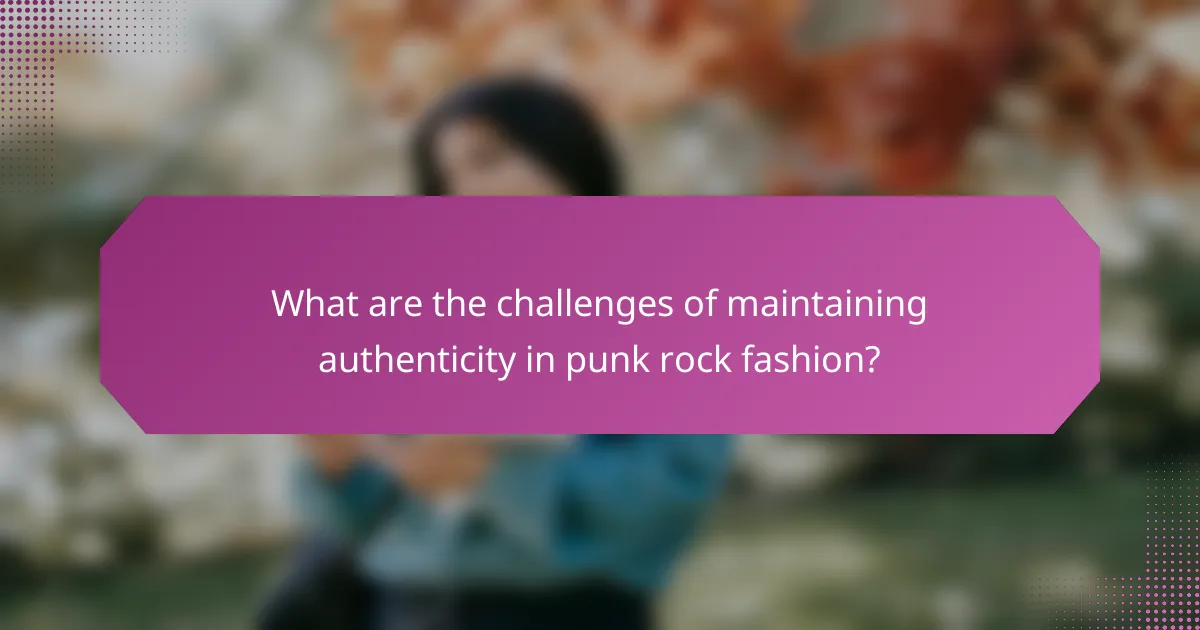
What are the challenges of maintaining authenticity in punk rock fashion?
Maintaining authenticity in punk rock fashion faces challenges like commercialization and dilution of original ideals. As punk style becomes mainstream, its core values risk being overshadowed by trends. The struggle to balance personal expression with commercial appeal complicates the scene. Additionally, the evolution of punk fashion often leads to generational divides, where newer interpretations may stray from foundational aesthetics.
How do commercialization and mainstream adoption impact punk rock fashion?
Commercialization and mainstream adoption dilute punk rock fashion’s rebellious essence. As brands adopt punk aesthetics, they often strip away the subculture’s authenticity. This shift leads to a homogenization of styles, where unique attributes like DIY elements and individual expression become rare. The initial roots of punk fashion, characterized by anti-establishment sentiments, face challenges as commercial interests prioritize profit over genuine expression.
What are the common misconceptions about punk rock fashion?
Punk rock fashion is often misunderstood as merely chaotic or rebellious. Many believe it lacks depth, but it actually embodies a rich history and cultural significance. Common misconceptions include that punk fashion is solely about leather jackets and spikes, ignoring its diverse influences from various subcultures. Additionally, some think it is only for a select group, while in reality, punk fashion encourages personal expression and inclusivity. Another myth is that it is outdated; however, punk elements continue to inspire modern fashion trends.
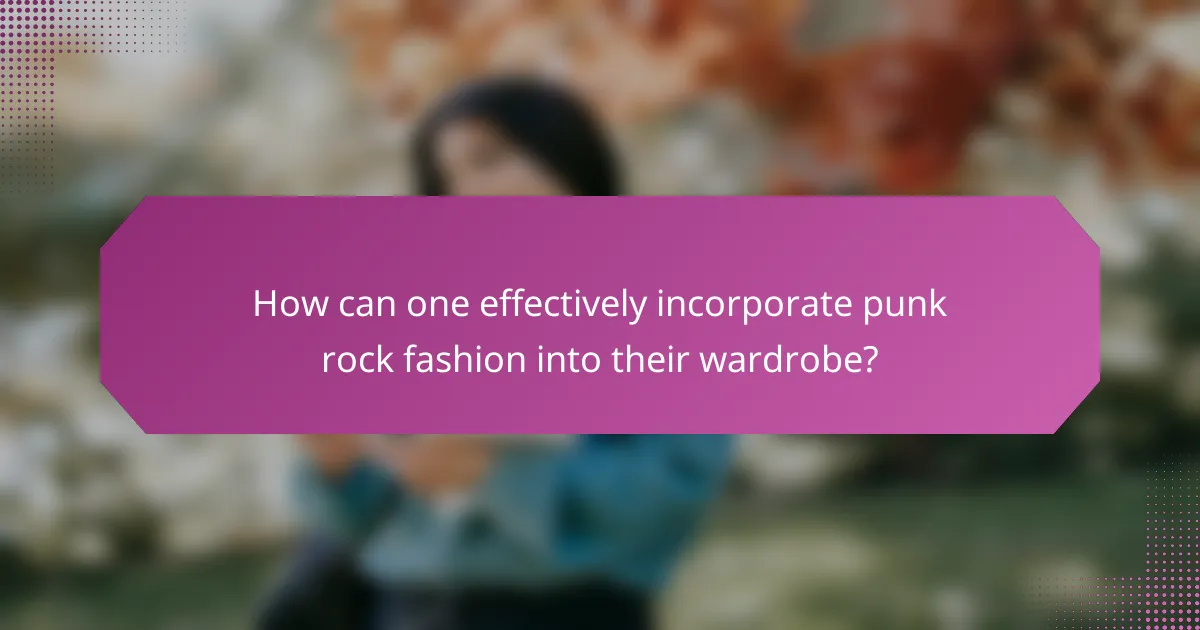
How can one effectively incorporate punk rock fashion into their wardrobe?
To effectively incorporate punk rock fashion into your wardrobe, focus on key elements like leather jackets, graphic tees, and distressed jeans. Layering is essential; mix textures and patterns for an authentic look. Accessories like studded belts and combat boots enhance the style. Embrace bold colors and prints, reflecting the punk ethos of individuality.
What are some essential pieces to include for a punk rock look?
To achieve a punk rock look, include essential pieces such as a leather jacket, band t-shirts, ripped jeans, combat boots, and accessories like studs and chains. These items define the rebellious spirit of punk fashion.
Key elements:
– Leather jacket: iconic outerwear that embodies punk attitude.
– Band t-shirts: showcase musical influences and personal style.
– Ripped jeans: represent a DIY aesthetic and nonconformity.
– Combat boots: practical footwear that complements the edgy look.
– Accessories: studs and chains enhance the punk vibe and individuality.
Which styling tips can enhance a punk rock outfit?
To enhance a punk rock outfit, focus on layering, bold accessories, and unique footwear. Mixing textures like leather, denim, and plaid creates visual interest. Accessories such as studded belts, chokers, and pins add personality. Statement boots or combat shoes complete the look, providing both style and comfort.
What common mistakes should be avoided when adopting punk rock fashion?
Avoiding common mistakes in punk rock fashion ensures authenticity and style. Key errors include neglecting the DIY ethos, which is central to punk culture, and over-commercializing outfits, leading to a loss of individuality. Another mistake is failing to mix vintage and modern pieces, which can create a stale look. Additionally, ignoring the importance of accessories, such as studs and patches, can result in an incomplete aesthetic. Lastly, not understanding the historical influences of punk can limit personal expression and authenticity.
How can one balance personal style with punk rock influences?
To balance personal style with punk rock influences, incorporate key punk elements while maintaining individuality. Mix classic punk pieces, like leather jackets and band tees, with unique accessories. Experiment with color, patterns, and textures to express personal taste. For example, pairing a vintage band shirt with tailored pants can create a stylish look that nods to punk roots.
